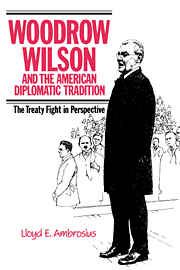Book contents
- Frontmatter
- Contents
- Preface
- Acknowledgments
- List of abbreviations
- 1 Introduction: Wilson's new world
- 2 Origins of Wilson's league of nations idea
- 3 Drafting of the League of Nations Covenant
- 4 American criticism of Wilson's peacemaking
- 5 Revision of the League of Nations Covenant
- 6 The question of control at home and abroad
- 7 The Versailles Treaty in the Senate
- 8 American rejection of the Versailles peace
- 9 The aftermath of Wilson's peacemaking
- 10 Epilogue: Wilson's legacy
- Bibliography
- Index
4 - American criticism of Wilson's peacemaking
Published online by Cambridge University Press: 18 September 2009
- Frontmatter
- Contents
- Preface
- Acknowledgments
- List of abbreviations
- 1 Introduction: Wilson's new world
- 2 Origins of Wilson's league of nations idea
- 3 Drafting of the League of Nations Covenant
- 4 American criticism of Wilson's peacemaking
- 5 Revision of the League of Nations Covenant
- 6 The question of control at home and abroad
- 7 The Versailles Treaty in the Senate
- 8 American rejection of the Versailles peace
- 9 The aftermath of Wilson's peacemaking
- 10 Epilogue: Wilson's legacy
- Bibliography
- Index
Summary
During the drafting of the Covenant, Wilson's supporters and critics in the United States prepared for the anticipated fight. Despite the Republican victory in the congressional elections of 1918, the Democratic president intended to implement his plans for postwar peace. To a very limited extent, he was willing to recognize the legitimacy of criticism and make revisions in the draft Covenant. He welcomed suggestions from Republicans as well as Democrats, but only on his own terms. He generally dismissed Republican alternatives as partisan and reactionary attacks on his forward-looking vision of a league. Relying on the Democratic party, Wilson expected to take his case to the American people and thereby force the Republican-controlled Senate to approve the peace treaty. He entrusted the future to confrontation rather than compromise. Republican leaders prepared for the confrontation. Unwilling to allow the Senate to play a submissive role, they organized in Washington and throughout the country to force the president to take their views into account. If he ignored them, they would jeopardize his plans for a postwar league.
After presenting the Covenant to the peace conference, Wilson returned to the United States temporarily for the close of the outgoing Congress. On his arrival he was obviously in “a fighting mood.” Landing in Boston, he challenged Lodge. All nations were united in their universal desire for a league, the president asserted.
- Type
- Chapter
- Information
- Woodrow Wilson and the American Diplomatic TraditionThe Treaty Fight in Perspective, pp. 80 - 106Publisher: Cambridge University PressPrint publication year: 1987



